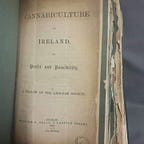Report On Irish Hemp Seed Oil From 1937
By Brian Houlihan
(Please consider becoming a patron to support the creation of more unique content)
In a secondhand bookshop I recently discovered a copy of a report published in 1937 by Cork University Press about oils made from plants, including hemp. The report is called ‘Oils from Irish grown plants’ and was written by Professor Joseph Reilly and Denis F. Kelly of University College Cork.
The report is partly based on research carried out in 1935 and 1936 on a range of plants. During this period a number of crops were under investigation by the Chemistry Department in UCC. The crops investigated included: Linseed, Rape, Hemp, Poppy, Mustard, Sunflower, Soya Bean and Mercurialis Annua (annual mercury) and others.
There was a research plot on college grounds where plants were grown by Mr. Galvin the head gardener of the college. Research plots was also grown in Mallow (Cork) by Mr. MacLysaght and in Dublin by Mr. O’Gorman. The seeds used for growing the hemp were obtained from Vilmorin Andrieux in Paris.
It’s worth noting this report was issued just months before Eire/Ireland was taken as the state’s official name following the ratification the 1937 constitution. Hence the Irish Free State/Saorstát Éireann is referenced throughout the report.
At the time the Irish Free State was reliant on the importation of various goods including products made from oils. The research was conducted according to the authors “in an effort to examine the possibility of home grown oil seed products displacing imported materials”.
The researchers were also keenly aware of the value these new industries would have domestically. “The growing of oil-seed crops in this country would provide a new cash crop for some of the farming population and give employment of an agricultural nature”. The authors also stated that “it would provide another outlet for our university graduates in Chemistry and Agriculture.”
Above is a photo taken on August 28th 1935 of hemp growing in UCC which is included in the report. Apologies for the low quality (for various reasons) but it gives you an impression at least.
According to the report the hemp plants (in 1935) were sown at the beginning of May and harvested towards the end of September. It’s stated that “the crop developed in a very satisfactory manner” and that the plants grew to 6 or 7 feet tall.
The report states that based on “chemical analysis and technical applications” the oil from hemp seed and sunflower seed would have economic value in Ireland. Although based on statements elsewhere in the report it seems that farmers found both hemp and sunflower difficult to grow and work with.
The researchers found that 98lbs (44.5 kilograms) of seed was obtained from 0.06 acres of hemp. Later analysis showed that the seeds contained 33% oil. The left over ‘cake’ from the hemp seed oil was proposed to be used as cattle feed.
Pages 54 to 58 of the report are dedicated solely to hemp seed oil. These pages highlights general information about hemp, soil preparation and the cultivation and harvesting processes. There’s also interesting but complicated technical information on hemp seed oil following the authors chemical analysis of it. Those with a background in chemistry would particularly find this section interesting.
In the report it’s outlined that “no experiments were carried out on the fibre.” While presumably out of their remit, since they were looking at oils, it would have been fascinating had the researchers undertaken experiments with hemp fibre. Due to the fact as the authors state themselves that “the hemp plant is mostly grown for fibre.”
The report also includes some accounts from those who participated in the research. The experiences from hemp growing at Mr. MacLysaght’s nursery in Mallow is outlined. They also grew sunflower, rape seed, poppy, linseed (flax), mint and lavender at their nursery as part of their work with UCC.
Their account opens by stating “For the last two years we have grown hemp at Hazelwood with little or no success”. The rest of their account outlines some of the difficulties they faced. Poor weather, be it a severe frost after sowing, or continuous rain throughout the cycle, lead to poor results in the first season. Although they stated the frosty weather conditions were particularly unique in its severity.
In their account they state that hemp “is not a very hardy subject, and unless great care is to expended a crop will not be produced”. They later conclude that “we doubt if it would be a commercial proposition”.
The account of Mr. O’Gorman, of the Albert Agricultural College, is also included in the report. He grew a number of plants at a plot in Glasnevin in Dublin as part of the research. Unfortunately things didn’t get off to a great start. He writes that part of the hemp crop was “by an unfortunate oversight ploughed up when the plants were just above ground.”
He later adds that the surviving plants “grew quite well and also ripened seeds.” However in conclusion he writes that “Hemp I am not too sure of. It might be too troublesome for the yield which it gives.”
Mr. Glavin, the head gardener at UCC, also included his account in the report. His report from 1935 doesn’t state much on hemp aside from his planting methods. Although he is happy to report that in early May all of the plants, including hemp, survived a frost.
His preliminary report for the 1936 season, written before harvest, simply states that “the hemp is healthy and is more forward that last year’s crop at the present stage.”
The report ‘Oils from Irish grown plants’ will soon be on display in the Dublin Hemp Museum
Brian Houlihan is the curator of the Dublin Hemp Museum and regularly writes about hemp. Follow him on Twitter at @dubhempmuseum and @houlihanbrian. You can also find us on Facebook.
